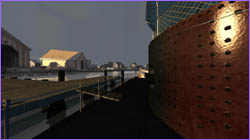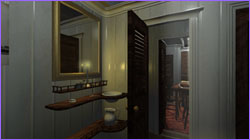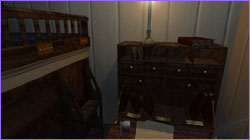 |

|
by Michael Burz In 1995 my studio initiated a project to digitally recreate the battle between the Civil War-era ironclads USS Monitor and CSS Virginia. We set out to examine an event that had become a well-recognized but not deeply understood symbol of the Civil War. Our goal was to present a detailed and accurate historic recreation of the ironclads in order to more fully appreciate their significance. We wanted the computer screen to serve as a window into 1862, a virtual time machine. It took six months of research into the history of the battle and Civil War-era ironclads, and eight months of digital modeling, to reconstruct the two ships in precise detail. (Only the Monitor reconstruction appears here.) The challenges were enormous. There are only eight known photographs of the exterior of the Monitor, and none of her interior. No known photos of her construction exist either, probably because no one save her designer John Ericsson expected her to actually work or survive. Her brief existence did not provide many photo opportunities: She sank in a storm only nine months after her initial battle. turret rotating mechanism, from the gears below deck in the galley area, to the donkey engine that powered them, to the control levers in the turret. We also reconstructed Ericsson's steam engine in operation, its configuration carefully worked out and its action taken from the inventor's patent model. In Tour the Monitor, you see one part of all this effort—the animated panoramas of the Monitor. Details to look for in the virtual rooms include light shafts streaming down from deck-mounted portholes; the tools and gauges in the engine room; the working parts of the massive Dahlgren guns in the turret; and the safety lanterns on the berth deck. On deck, look on shore for the large shed, a reconstruction made from a photograph of the actual shed in New York in which the Monitor was built, and the ship's boats, which we meticulously modeled from original Navy drawings.
The Monitor's captain, Lt. John Worden, had two rooms to himself as befitted an officer and a gentleman. Worden's cabin and stateroom are accurate as to their configuration and furnishings, though we did take license with their decoration. The desktop, for instance, contains a map, a model of a cannon, and other artifacts, which are conjecture. The shaving equipment and sword are of the period, however. For textures, colors, and environmental effects in the engine room, we paid a visit to the USS Jeremiah O'Brien. The last surviving D-Day troop ship, now a museum in San Francisco, her steam engine was based on one designed in the late 1800s and thus provided us with the right atmosphere.
In attempting this historical recreation, we were fortunate to have the assistance of a fellow enthusiast, the naval historian Colan Ratliff. We were also grateful for the generous and valuable support of the Monitor National Marine Sanctuary through Ms. Dina Hill. The Sanctuary supplied us with many documents, including a book of Ericsson's drawings lovingly prepared by the late U.S. Naval Historian Capt. Ernst Peterkin. We would also like to thank our spouses and partners, who supported us during this endeavor. I especially want to acknowledge my wife Christi, who provided much-needed support and guidance throughout this project. We, the team that rebuilt the Monitor, hope you enjoy your tour. Ron Cobb, Art Director Mitch Suskin, Digital Effects Director Sean Wagstaff, Chief 3-D Artist Craig Lyn, Senior 3-D Artist Evan Pontiero, Senior 3-D Artist Emmanuel Shiu, Senior 3-D Artist Brian Flora, Backgrounds Steve McEntee, Interface Art Michael Burz, Producer, Chief Engineer Tour the Monitor | Behind the Scenes Eyewitness to the Battle | Steam Machine | Resources Transcript | Site Map | Lincoln's Secret Weapon Home Editor's Picks | Previous Sites | Join Us/E-mail | TV/Web Schedule | About NOVA Watch NOVAs online | Teachers | Site Map | Shop | Search | To Print PBS Online | NOVA Online | WGBH © | Updated May 2003 |



